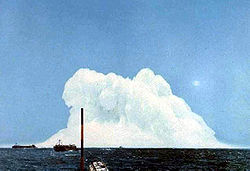- Mark 90 nuclear bomb
-
The Mark 90 nuclear bomb, given the nickname "Betty", was a cold war nuclear depth charge, developed by the United States in 1952.
It had a length of 10 ft 2 in, a diameter of 2 ft 7.5 in, and a weight of 1,243 lb, and it carried a Mark 7 nuclear warhead with a yield of 5-10 kilotons. Its purpose was to serve as an anti-submarine weapon for the United States Navy.
A test of the Mark 90 was conducted in 1955, as Operation Wigwam.
All units were withdrawn from service by 1960.
Accident
On September 25, 1959, a United States Navy Martin P5M-2 Marlin (BuNo 135540, SG tailcode, '6', of VP-50) was patrolling out of NAS Whidbey Island, Washington on Puget Sound, when it was forced to ditch in the Pacific Ocean, about 100 miles west of the Washington-Oregon border.[1]
A Mark 90 depth charge casing was lost and never recovered, but it was not fitted with an active warhead. The ten crew were rescued by the US Coast Guard, after ten hours in a raft. The press was not notified at the time.[2]
References
- ^ Maggelet, Michael H., and Oskins, James C., "Broken Arrow: The Declassified History of U.S. Nuclear Weapons Accidents", www.lulu.com, 2007, ISBN 978-1-4357-0361-2, page 128.
- ^ Gibson, James N. Nuclear Weapons of the United States - An Illustrated History . Atglen, Pennsylvania.: Schiffer Publishing Ltd., 1996, Library of Congress card no. 96-67282, ISBN 0-7643-0063-6, Chapter 12, "Nuclear Anti-Submarine Weapons", page 214.
External Links
Categories:- Cold War anti-submarine weapons of the United States
- Cold War nuclear bombs of the United States
Wikimedia Foundation. 2010.

